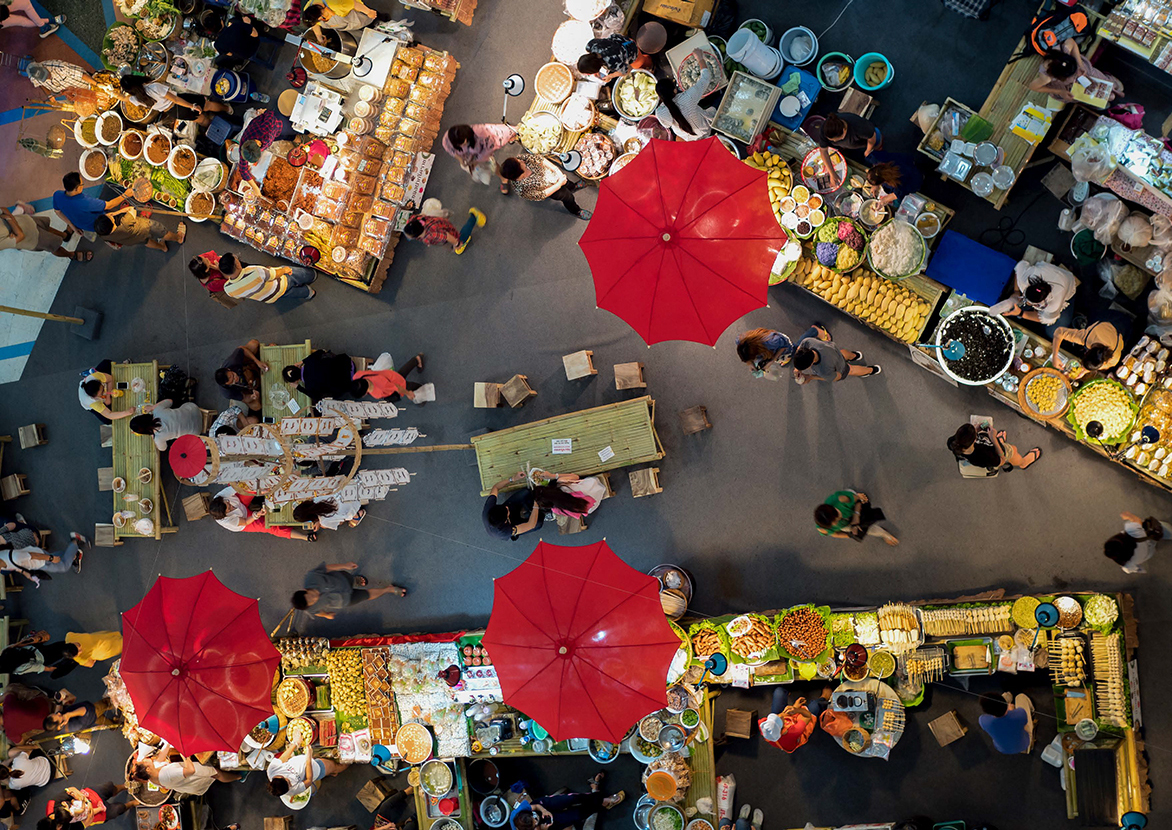Antigua, Guatemala—On a recent afternoon in this historic Central American city, a local artisan took me on a walking tour to see some of his handiwork. Fernando Rivera, 44, specializes in what he calls “modifying.” What he modifies are vehicles—everything from school buses to heavy cargo trucks. He’s most known for a specialty: repurposing three wheeled taxi scooters, or rickshaws, that folks here call “tuk tuks.” Tuk tuks mostly are imported to Guatemala from India, under the TVS and Bajaj brands, although the Piaggio brand from Italy occasionally finds its way to his shop. What he modifies them into is entirely up to the customer. He’s mobilized a veterinary clinic for use in neutering stray dogs and put cookstoves on passenger seats so street chefs can serve crepes and burgers. You name it, and he can create it, he says. “Anything from a car wash to a florist shop to a pet spa. We’re limited only by the imagination of our buyers.”

His buyers’ imaginations whizz by everywhere
There goes a tuk tuk from Mr. Jeff’s, a dry cleaning chain whose delivery vans resemble tall armoirs vertical enough to hang freshly pressed shirts, suits and trousers, yet are also narrow enough to maneuver through tight urban alleyways.
Another customer, Calista, commissioned tuk tuks that serve as snack bars for garden parties. Instead of rolling passengers through traffic, Calista’s vehicles carry a tiny mobile kitchen whose stove, oven and prep chambers rest on a 4’ by 6’ chassis. Counters flip open from side panels and snap assemble into buffets, sometimes with drop-down seating. That model is a big hit with caterers in this city, popular as a wedding destination. Instead of using a hotel’s kitchen (and paying to keep teams of cooks and waiters on salary) a single cook in a Calista tuk tuk can drive up to private homes and handle everything from arrival to cleanup for dozens of guests.Tuk-tuk’s are even more ubiquitous across rural Guatemala, whose 20 million citizens comprise Central America’s largest country. Tuk tuk use is booming, especially in villages that today are sending thousands of sons and daughters north seeking work in the United States.
Some 850,000 Guatemalans have made the trip since the start of this decade. In fact, since 2019, Guatemalans trail only Mexicans (who sent 2.4 million to the border) in the total number of would-be arrivals tallied by Customs and Border Patrol agents on the US’s southwestern border.

Even though many of those attempting to cross are captured and sent back into Mexico, most keep trying to enter the US and often (eventually) succeed, either by evading capture or petitioning for asylum. The lucky ones who find jobs and save enough money to send home to their families often urge their families to start small businesses that multiply employment at home. Tuk-tuks provide a popular vehicle that transforms earnings made in the US into further earnings made in Guatemala. Just look at the numbers. Last summer Guatemalan tax authorities reported that between March 2016 and March 2023 the nation imported just under 50,000 tuk-tuks, noting that, to date, some 33,000 vehicles remain in operation as businesses.

Comparing those 33,000 vehicles operating now and the 850,000 migrants who left Guatemala in the past half decade, we might calculate one tuk-tuk has been sold for every 25 Guatemalans who leave. Or, in other words, while only 4% of migrants choose to put their families into the tuk-tuk business, there are so many Guatemalans heading north 4% still translate into thousands of new tuk tuk businesses created back home.

Consider one hamlet, called Chel, in the department of Quiché, lying in the heart of Guatemala’s Ixil Triangle, its busiest migrant-sending region. This is coffee country, where some of the Guatemala’s richest beans are grown. Fifty years ago, this tiny crossroads was in the middle of a civil war, with thousands of its Mayan-speaking citizens fleeing into Mexico to escape the violence. They began returning in the 1990s, but in the last decade they began leaving again in search of better opportunities, either for education in Guatemala’s larger cities or for jobs in the US.
Today almost every family in Chel has a member in the US. And almost every migrant family owns or works with tuk-tuks. According to authorities, there are 350 tuk-tuks in operation across Chel and neighboring towns, or roughly one for every forty households. With so much competition among tuk tuk drivers, it seems very few families are getting wealthy operating as taxi drivers. Instead, tuk tuk operators function more as facilitators within a difficult economic framework.

Here’s how:
First there’s the cost, about $7000 for a new tuk-tuk, which usually includes free repairs during the first year of operation. Tuk tuk operators here say they expect to cover the $7000 purchase within two years of buying, which means earning $3500 per year for two years. That works out to profits of $10 per day per tuk tuk, after paying for gasoline and labor (that is, the driver). Most families say the “labor” is someone from the same family, often a young adult or teenager. In cases where a non-family member drives the tuk tuk, the owner usually makes a contract with a driver who must pay for his own gasoline, plus a $10 daily rental fee. It’s then up to the driver to make enough trips to earn enough cash to cover these costs, and still make a profit to keep for hours spent behind the wheel. In Comitancillo, a municipio in the department of San Marcos, I met Mayan leader Ruben Feliciano, an elder who had his own view of tuk-tuk economics. When asked, Feliciano affirmed there’s been an explosion of the three-wheeled, motorized mini-taxies across his municipio. He estimated Comitancillo’s tuk-tuk fleet exceeds 200 vehicles, guessing that 40% of those mini-taxies are being purchased with remittance cash sent by family members working abroad. He noted that while these taxis are often forbidden in the center of bigger towns, they are busy working in the mountains—by the hundreds each day—connecting hillside villages where peasants until recently traveled almost exclusively by horse or donkey, or on foot, often without shoes. For that reason alone, this community leader called tuk-tuk travel a boon to human mobility here. That means folks can get to medical appointments or order a shipment of household goods and bring them home to their farms the same day. Or that students can attend classes and merchants can move items more efficiently. These are tasks that used to take days to perform, and now can be completed in minutes.

Individual tuk-tuk “trips” around Comitancillo cost as little as three Quetzales (less than 50 US cents), and up to as much as 100 Quetzales ($18 USD), for example for a one-hour ride into a distant hamlet. Sunday afternoons are when whole families squeeze into a tuk-tuk and splurge to visit other family members, sometimes at some distance—it’s an extravagance, yet at the same time a form of commerce and entertainment made possible by migration. My own calculations indicate tuk-tuks generating $30 per day in taxi trips would leave the driver with earnings of $10 per day, which equals what a farm laborer can make in places like Chel or Comitancillo. To be sure, to make $10 a day doing tuk-tuk work is an enormous improvement over the same $10 farmers pay for a day laborer, who often must hike steep hillsides and then swing a machete under a hot sun. While it’s true that $10/day is a tiny fraction of a daily wage almost any migrant could make working in the US, it’s $10 one can make without borrowing thousands of dollars to journey north, which also involves risking one’s life with no guarantee of success.
In that way, tuk tuks aid families by creating small increments of wealth that enable their members to pursue other avenues to advancement on the side. A student, for example, who might work afternoons and evenings after classes, or a farmer who hires out his tuk tuk to help other farmers deliver coffee beans at harvest time. Tuk-tuks, in short, can help keep rural Guatemalans rooted to a daily rhythm of the life they already know. IOM, the International Organization for Migration, in Guatemala calls this the “arraigo” factor, for the Spanish word for “rootedness.”

In another municipio, San Miguel Ixtahuacán I had chance to speak with tuk-tuk driver named Milton. He told me the tuk-tuk he bought for 36,000 Quetzales is being paid off at a rate of 1000 Quetzales per month to his prestimista, the local money lender. Milton noted he does have relatives working in the US, but so far none have offered to finance his tuk-tuk.
Milton works six days a week, and treasures Sunday, when families use tuk-tuk rides to visit relatives in outlying districts. On an average day, Milton says he’s satisfied with earnings of 250-300 Quetzales. That means, he earns his monthly loan payment in just four days. His gross averages some 7,000 Quetzales per month, or about $700 USD.
After subtracting the cost of gas, Milton could expect to earn the equivalent of USD $400-$500 per month. That’s about what the better jobs offer in San Miguel Ixtahuacán’s center, usually as a store clerk or secretary. So, even if his wages are not lavish, Milton is building equity in his vehicle, which he then can sell when he is ready to quit the business or upgrade to a new model. I met other drivers who hire themselves out to tuk-tuk owners, hoping one day to be owners, themselves.
At the same time there is the looming threat of over-saturation. Drivers refer to “lines,” which are designated spots on the pavement where tuk-tuk trios are permitted to “line” up for customers. Tuk-tuk profits depend on being able to serve customers without cruising in constant motion, which consumes gasoline. With 120 tuk tuks already registered as businesses here, Milton says there aren’t enough “line” spots for all who want them.

Which brings us back to Fernando Rivera and his business modifying tuk-tuks into businesses that do more than offer taxi services. Mr. Rivera explains he got his start modifying tuk-tuks when a neighbor complained that his car wash business was being extorted by one of Guatemala’s notorious street gangs. As it turned out, the car wash was on a busy city boulevard, but the owner lived in an exclusive gated community. He was physically safe at home, but no longer at work. Rivera figured out a way to mount car wash equipment—hoses, water tanks, rotating brushes—on a tuk tuk and persuaded the businessman to clean cars only inside the gated community. It worked.
Tuk tuk modification will not keep Guatemalans from migrating abroad, of course. There are signs tuk tuk owners are ready to go well beyond taxi services and make more sophisticated offerings. That will lead to even more commercial activity. Already Guatemala’s largest food corporation—Corporación Multi Inversiónes, or CMI, owners of the mammoth Pollo Campero restaurant chain—has deployed over 100 chicken delivery tuk tuk’s in Guatemala and El Salvador.
At the same time, the United Nations Development Programme (UNDP) has teamed in Guatemala with Korea’s Hyundai Motor Co. on an Accelerator Lab to incubate sustainable technologies and identify local innovators in the Global South. One of the Lab’s premier accomplishments in Guatemala is the development of a solar-powered tuk tuk to reduce CO2 emissions and reduce noise pollution. At its unveiling the UN team explained the model sports a flatbed of photovoltaic panels on its roof — creating an environmentally friendly alternative to a vehicle that otherwise generates about 4 tons of carbon dioxide emissions in Guatemala annually.





